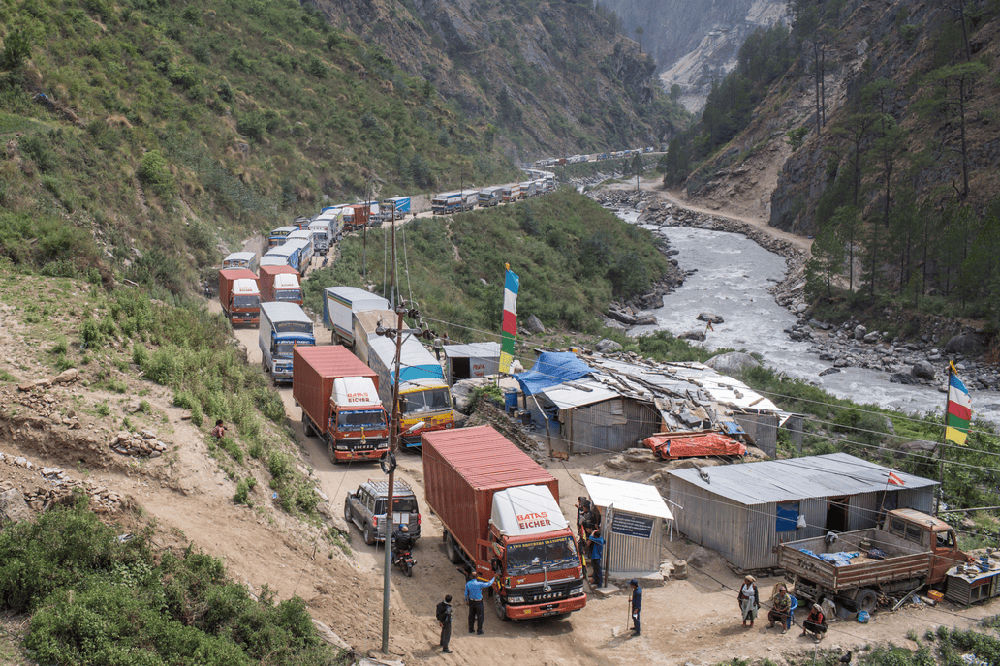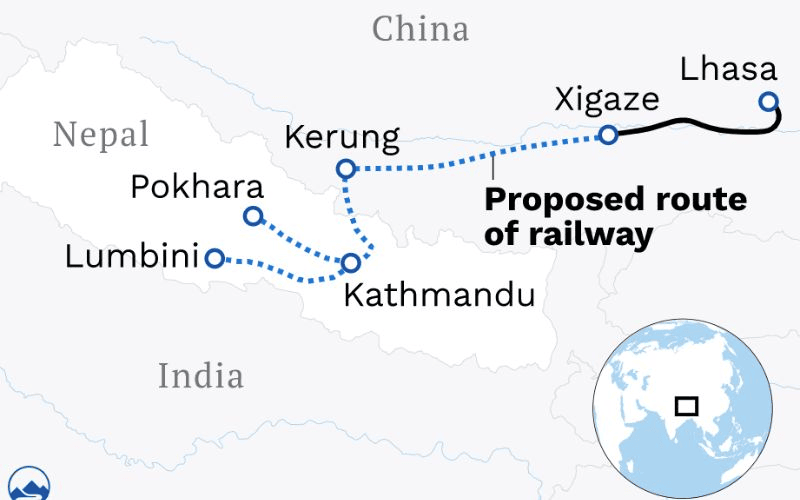Overview of the Tibet-Nepal Railway Project

China has announced that it will begin a feasibility study for the ambitious Tibet-Nepal Railway within a year. This 170-kilometer railway, part of the Belt and Road Initiative (BRI), aims to link Kerung in southern Tibet with Kathmandu, Nepal’s capital, before potentially extending to India. The project is expected to cost approximately 38 billion yuan (USD 5.5 billion), a considerable investment that reflects the complexity and challenges of the terrain.
Key Highlights
1. Feasibility Study:
- Timeline: The study is set to commence within a year and will be funded by China.
- Goals: It will determine the optimal route, including ground and bridge proportions, and the type of railway required, whether high-speed or conventional.
- Investment: China has pledged RMB 800 million (USD 118 million) for Nepal in 2022, covering the feasibility study cost.
2. Project Costs:
- Construction Costs: The entire railway is projected to cost around 38 billion yuan, with significant expenses on the Nepalese side due to challenging geological conditions.
- Cost Distribution: Although only one-third of the railway’s length is within Nepal, this portion accounts for nearly half of the total cost due to the difficult terrain and climate.
3. Technical Challenges:
- Geological and Climatic Conditions: The railway must traverse the lofty and fragile Himalayan range, making it one of the world’s most challenging railways to construct.
- Chinese Expertise: China’s experience with high-altitude railways, such as those in Tibet, will be crucial for overcoming the technical challenges posed by this project.
4. Engineering Influence:
- Technological Prowess: The project will showcase civil engineering advancements, including tunneling through difficult terrain and designing structures to withstand environmental stresses.
- Infrastructure Development: This railway could become a key transit point, linking China’s and India’s railway networks and enhancing regional connectivity.
5. Environmental Concerns:
- Ecological Impact: There are significant concerns about the project’s impact on the fragile Himalayan ecosystem.
- Government Response: Both Nepal and China must consider and mitigate environmental risks. Despite Nepal's lack of capacity to review technical reports due to a shortage of railway engineers, the feasibility study will be led by Chinese experts, with hopes for consultation with Nepalese authorities.
6. Geopolitical Implications:
- Regional Dynamics: The project holds considerable geopolitical significance, with India being particularly sensitive to increased Chinese influence in Nepal.
- Historical Context: Discussions about a Nepal-China railway date back to 1973, when Chairman Mao Zedong first mentioned the idea to Nepal’s King Birendra Shah.
- Strategic Importance: If successfully connected to India’s railway network, this project could enhance economic bonds between China and India and provide strategic benefits in times of geopolitical tension.

Detailed Breakdown
- Feasibility Study: The study, funded by China, will identify the best route and determine the type of railway needed. It will assess technical aspects, such as ground and bridge proportions, and consider high-speed versus conventional rail options.
- Technical Difficulties: The project involves navigating the complex geology of the Himalayas, including the main central thrust, a geologically weak zone. Advanced engineering solutions will be essential for successful construction.
- Environmental Impact: The railway’s ecological impact is a major concern. The fragile geology and the environmental sensitivity of the region necessitate careful planning and mitigation strategies.
- Geopolitical Context: The railway is a significant geopolitical project, reflecting China’s strategic interests in the region. Historical ties and recent diplomatic efforts highlight the project’s importance to China-Nepal relations and its potential impact on regional dynamics.
The Tibet-Nepal Railway project is a remarkable and ambitious endeavor that highlights the advancements in civil engineering and international cooperation. From an engineering perspective, constructing a railway through the Himalayas is an extraordinary challenge, given the region's complex geology, high altitudes, and extreme weather conditions. China's expertise in high-altitude railway construction, as demonstrated in Tibet, will be invaluable in navigating these obstacles. The successful completion of this project would be a testament to human ingenuity and resilience.
However, the project also raises significant environmental and geopolitical concerns. The fragile Himalayan ecosystem is particularly sensitive to large-scale infrastructure projects, and the potential ecological impacts must be thoroughly assessed and mitigated. Both China and Nepal must prioritize environmental sustainability and ensure that the railway does not cause irreversible damage to the region.
Geopolitically, the project is strategic for China, enhancing its influence in Nepal and potentially facilitating stronger economic ties with India. This aspect of the railway has both positive and negative connotations, as it could foster regional connectivity and economic growth but also heighten tensions with India.
In summary, the Tibet-Nepal Railway project is a bold and impressive initiative that underscores the potential of modern engineering to connect regions and foster development. However, it must be approached with a careful balance of technological innovation, environmental responsibility, and geopolitical sensitivity to ensure that its benefits are maximized while minimizing adverse impacts.
The Tibet-Nepal Railway project represents a monumental undertaking in civil engineering, illustrating the capabilities and challenges of constructing infrastructure in extreme environments. Its success hinges on careful planning, technological innovation, environmental stewardship, and geopolitical negotiations. The railway could significantly enhance regional connectivity, economic development, and international collaboration if executed thoughtfully. This project stands as a testament to the power of engineering to bridge even the most formidable natural barriers, bringing nations closer together.




















